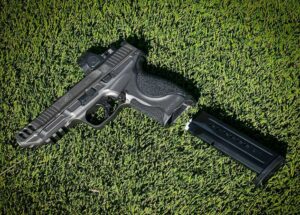July 22, 2021
By Ken Finley
What got me into gunsmithing originally, was breathing new life into Closet Hermits. Sitting in closets throughout America are old firearms that Granddad used to shoot, but no one takes them out anymore. So, I was delighted the other day when a friend brought an old Colt .45 Single Action Army revolver to my shop. The revolver’s owner wanted the pistol for a display piece that actually worked.

There was no blue anywhere on it. It was all a pitted gray color (what we now call patina instead of very worn). The grips were a well-worn smooth walnut. I couldn’t even make out the serial number so I have no idea of the revolver’s age. With the intent of making it functional again, someone had bought a used trigger, a used hammer, a used cylinder stop and a new trigger spring. The used parts had all come from different pistols. In short, this was a “box of parts” or “bag” gun project.
With today’s modern CNC machining capability, you can mix and match parts with a reasonable degree of success. Try that with something like this old Colt and you are in for a trying time. Each of those parts had been originally fitted to a specific pistol and there is no knowing what the tolerances were. The end result was, when my friend tried to reassemble this pistol, it froze solid. If he could get the hammer back, the trigger wouldn’t move. If he took out one spring, the hammer would go back to full cock, but the safety notch and half cock didn’t work. If he could get it to go to half cock, the cylinder wouldn’t spin. In this situation, you go back to the basics.
Every part was examined for rough edges, and those either filed, stoned, or polished with jewelers’ rouge. Critical surfaces were trued and polished. Bearing surfaces were also polished for the least possible friction. In each case, as little metal was removed as possible following the adage that it is easier to remove more than to put any back. Since the parts all fit inside the revolver frame, you can’t see how they move together so it is a trial and error fitting process. In this instance, my first change was to adjust the trigger spring because it didn’t seem to be moving the trigger to engage the stops on the hammer. The hammer stops for safety notch, half-cock and full-cock weren’t deep enough to engage the trigger sear and there was a burr on the full-cock notch that seemed to lock the trigger. After several trials, the revolver began to respond in a correct manner. Adjusting the angle of engagement between the trigger and the full-cock hammer notch yielded a crisp, smooth release and the cylinder stop began to correctly lock and unlock the cylinder allowing it to spin at the appropriate times.
Was this old pistol worth all the effort to just be a display piece? In my opinion, yes. The value of such an old firearm exceeds the hourly charge for such work – it is a Colt after all. Maintaining the patina actually enhances the value. On the other hand, there is another very practical consideration. The old .45 makes an excellent home defense pistol.

Compare .45 Colt ballistics with the current darling of the personal defense crowd – the 9 mm Luger or Parabellum. I won’t knock the 9mm – I’ve carried one for years – even when they weren’t the “in” thing. Typical velocities in the 9mm with either the 125 grain full metal jacket or the 115 grain jacketed hollow point range between 850 and 1200 feet per second. Ballistic coefficients range between .137 and .129 respectively and sectional densities of .142 and .130 respectively. With modern bullet designs that is respectable performance. The .45 Colt cartridge originated in the black powder days and we don’t tend to load them to as high a pressure, so velocities are lower – 700-900 feet per second. The surprise comes in with the bullet performance – a 200 grain jacketed hollow point has a ballistic coefficient of .138. That means the bullet has less trouble forcing its way through the atmosphere than the smaller 9 mm and sheds less velocity for a given distance. The sectional density for this bullet is .140, rivalling that of the heaviest 9 mm bullet in our example. But that isn’t the whole story – the much cheaper lead bullet – a 250 grain lead semi-wadcutter bullet has a ballistic coefficient of .269 and a sectional density of .175. That bullet will really nudge its target. Of course, it helps to remember the US Army specified a very similar load to take down opposing calvary officers’ horses. It is actually safer in the home as it is less prone to over penetration than the 9mm. The old Colt may not be the sexiest partner to bring to the dance, but it still knows all the steps. And as a display piece, it hides in plain sight.


